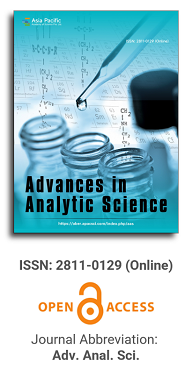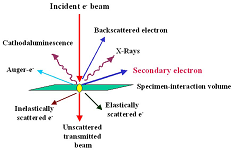
Asia Pacific Academy of Science Pte. Ltd. (APACSCI) specializes in international journal publishing. APACSCI adopts the open access publishing model and provides an important communication bridge for academic groups whose interest fields include engineering, technology, medicine, computer, mathematics, agriculture and forestry, and environment.

Geochemistry and source area weathering of soils around Mount Bamboutos (Cameroon Volcanic Line)
Vol 6, Issue 1, 2025
Download PDF
Abstract
This study aimed at investigating the weathering of the source area and the geochemistry of the soils around Mount Bamboutos, West Region, Cameroon. In this study, soil samples were collected from a depth of 0–40 cm. The soil samples were analyzed using inductively coupled plasma mass spectrometry (ICP-MS). Significant SiO2 (63.37–73.05 wt.%) content recalculated to an anhydrous basis and adjusted to 100% (SiO2 (adj)) indicates the abundance of quartz and kaolinite in soil samples. The enrichment of Al2O3 (9.98–15.12 wt.%) suggests the presence of aluminosilicate minerals such as clay minerals, muscovite, and feldspars. The considerable Fe2O3 (0.01–11.04 wt.%) content relates to the mechanical erosion of ferrallitic soil or to Fe-source rock weathering. The elevated LaN/YbN levels indicate that the soils were derived from heterogeneous source rocks during weathering. The inverse correlation between SiO2 and Fe2O3, MgO, TiO2, and P2O5 indicates the prevalence of heavy minerals, which are likewise influenced by the relative amount of quartz. The positive Ce anomalies may result from the redox conditions. Weathering indices such as the plagioclase index of alteration (PIA: 77.03%–97.75%), Chemical Index of Weathering (CIX: 58.25%–66.83%), chemical weathering index (CIW: 91.31%–99.13%), and chemical index of alternation (CIA: 50%–70%) all signify moderate to intense weathering in the source area, which occurred in hot, humid climatic conditions. This is evidenced by the removal of labile cations (Ca, Na, and K) in relation to stable residual components (Al and Ti). The relatively high Ce anomalies in the soil samples (Ce/Ce* = 0.01 to 7.44; average 2.39) suggest intense chemical weathering.
Keywords
References
1. Temga JP, Azinwi Tamfuh P, Basga Djakba S, et al. Characteristics, classification and genesis of vertisols under seasonally contrasted climate in the Lake Chad Basin, Central Africa. Journal of African Earth Sciences. 2019; 150: 176-193. doi: 10.1016/j.jafrearsci.2018.11.003
2. Azinwi PT, Temga JP, Temgoua E, et al. Characteristics, Source Area-weathering, Sedimentary Processes, Tectonic Setting and Taxonomy of Vertisols Developed on Alluvial Sediments in the Benue Trough of North Cameroon. Journal of Geosciences and Geomatics. 2022; 10(1): 1-17. doi: 10.12691/jgg-10-1-1
3. Yan Y, Yang Y. Uncertainty assessment of spatiotemporal distribution and variation in regional soil heavy metals based on spatiotemporal sequential Gaussian simulation. Environmental Pollution. 2023; 322: 121243. doi: 10.1016/j.envpol.2023.121243
4. Dengiz O, Usul M. Multi-criteria approach with linear combination technique and analytical hierarchy process in land evaluation studies. Eurasian Journal of Soil Science (EJSS). 2018; 7(1): 20-29. doi: 10.18393/ejss.328531
5. Azinwi TP, Djoufac Woumfo E, Temgoua E, et al. Moisture content, moisture-related properties and agricultural management strategies of the Benue floodplain vertisols in North Cameroon. African Journal of Agricultural Research. 2018; 13(33): 1730-1746. doi: 10.5897/ajar2018.13349
6. Yiika LP, Tita MA, Suh CE, et al. Heavy Metal Speciation by Tessier Sequential Extraction Applied to Artisanal Gold Mine Tailings in Eastern Cameroon. Chemistry Africa. 2023; 6(5): 2705-2723. doi: 10.1007/s42250-023-00652-0
7. Yiika LP, Jean-Lavenir NM, Monespérance MGM, et al. Contamination and risk assessment of heavy metals in stream sediments of Bambui area, western Cameroon. International Journal of Research and Innovation in Applied Science. 2022; 7(11): 64-75.
8. Afahnwie NA, Embui VF, Yiika LP, et al. Preliminary stream sediment geochemical exploration for base metals and other elements in terms of source apportionment and contamination status of Manjo and environs, Cameroon. Discover Chemistry. 2025; 2(1). doi: 10.1007/s44371-025-00183-2
9. Ndema Mbongué JL, Sigué C, Igor Fulbert MN, et al. Potentially toxic metals contamination in stream sediments of Mbal area (Pan-African fold belt, Cameroon). Discover Geoscience. 2024; 2(1). doi: 10.1007/s44288-024-00017-1
10. Ndema Mbongué JL, Tume NK, Yiika LP, et al. Contamination, sources and risk assessments of metals in stream sediments of Pouma area, Pan-African Fold Belt, Southern Cameroon. Water, Air, & Soil Pollution. 2023; 234(3). doi: 10.1007/s11270-023-06180-4
11. Tiabou AF, Takem-Agbor AA, Yiika LP, et al. Distribution, source apportionment and ecological risk assessment of heavy metals in Limbe River sediments, Atlantic Coast, Cameroon Volcanic Line. Discover Water. 2024; 4(1). doi: 10.1007/s43832-024-00120-x
12. Tiabou AF, Atabe GAA, Sigue C, et al. Appraisal of pollution, ecological and health risks assessment of trace metals in soils of Logbadjeck quarrying area, Nyong Series, Cameroon. Journal of Trace Elements and Minerals. 2024; 10: 100204. doi: 10.1016/j.jtemin.2024.100204
13. Tiabou AF, Mboudou GMM, Ghanyuymo MM, et al. Evaluation of surface and groundwater quality in Logbadjeck quarrying area: implications for trace metals pollution and health risk assessment. International Journal of Energy and Water Resources. 2025; 9(2): 893-915. doi: 10.1007/s42108-024-00321-z
14. Tiabou AF, Tanyi TAM, Yiika LP, et al. Spatial distribution, ecological and ecotoxicity evaluation of heavy metals in agricultural soils along Lala-Manjo Highway, Cameroon Volcanic Line. Discover Soil. 2024; 1(1). doi: 10.1007/s44378-024-00010-7
15. Tiabou AF, Esuka CN, Mbowou Ngantche IF, et al. Spatial Distribution, Contamination Characteristics and Eco-Risk Assessment of Toxic Metals in Stream Sediments of Njombe-Penja Banana Plain, Cameroon Volcanic Line. Chemistry Africa. 2025; 8(2): 619-639. doi: 10.1007/s42250-024-01159-y
16. Suh GC, Afahnwie NA, Tiabou AF, et al. Source apportionment, ecological and toxicological risk assessment of trace metals in agricultural soils of Wabane, South West Region, Cameroon. Journal of Trace Elements and Minerals. 2025; 12: 100218. doi: 10.1016/j.jtemin.2025.100218
17. Hasan O, Miko S, Mesić S, et al. Chemical Weathering Rates of Soils Developed on Eocene Marls and Sandstones in a Mediterranean Catchment (Istria, Croatia). Land. 2023; 12(4): 913. doi: 10.3390/land12040913
18. Gonçalves DAM, Pereira WV da S, Johannesson KH, et al. Geochemical Background for Potentially Toxic Elements in Forested Soils of the State of Pará, Brazilian Amazon. Minerals. 2022; 12(6): 674. doi: 10.3390/min12060674
19. Youmen D. Volcanological, petrological and temporal evolution of the Bambouto caldera (Cameroun). Allemagne: Christian-Albrechts-Universität zu Kiel; 1994; 274p + 2 Cartes.
20. Nguetnkam JP, Kamga R, Villiéras Ekodeck GE, Yvon J. Weathering response of granite in tropical zones. Example of two sequences studied in Cameroon (Central Africa). Etude et Gestion des Sols. 2007; 14(1): 13-41.
21. Déruelle B, Ngounouno I, Demaiffe D. The ‘Cameroon Hot Line’ (CHL): A unique example of active alkaline intraplate structure in both oceanic and continental lithospheres. Comptes Rendus Géoscience. 2007; 339(9): 589-600. doi: 10.1016/j.crte.2007.07.007
22. Nono A, Njonfang E, Kagou Dongmo A, et al. Pyroclastic deposits of the Bambouto volcano (Cameroon Line, Central Africa): evidence of an initial strombolian phase. Journal of African Earth Sciences. 2004; 39(3-5): 409-414. doi: 10.1016/j.jafrearsci.2004.07.026
23. Gountié Dedzo M, Diddi Hamadjoda D, Fozing EM, et al. Petrology and geochemistry of ignimbrites and associated enclaves from Mount Bambouto, West-Cameroon, Cameroon Volcanic Line. Geochemistry. 2020; 80(4): 125663. doi: 10.1016/j.chemer.2020.125663
24. Nni J, Nyobe JB. Geology and petrology of the precalderic lavas of the Bambouto Mountains: Cameroon Line (French). Geochemica Brasiliensis. 1995; 9(1): 47-59.
25. Gountié Dedzo M, Nédélec A, Nono A, et al. Magnetic fabrics of the Miocene ignimbrites from West-Cameroon: Implications for pyroclastic flow source and sedimentation. Journal of Volcanology and Geothermal Research. 2011; 203(3-4): 113-132. doi: 10.1016/j.jvolgeores.2011.04.012
26. Merle R, Marzoli A, Aka FT, et al. Mt Bambouto Volcano, Cameroon Line: Mantle Source and Differentiation of Within-plate Alkaline Rocks. Journal of Petrology. 2017; 58(5): 933-962. doi: 10.1093/petrology/egx041
27. Rudnick RL, Gao S. The composition of the continental crust. Treatise on Geochemistry. 2003; 3: 1-64. doi: 10.1016/B0-08-043751-6/03016-4
28. McLennan SM. Rare earth elements in sedimentary rocks: influence of provenance and sedimentary processes. In: Geochemistry and Mineralogy of Rare Earth Elements. De Gruyter; 1989.
29. Nesbitt HW, Young GM. Prediction of some weathering trends of plutonic and volcanic rocks based upon thermodynamic and kinetic consideration. Geochimica et Cosmochimica Acta. 1984; 48(7): 1523-1534. doi: 10.1016/0016-7037(84)90408-3
30. Cox R, Low DR, Cullers RL. The influence of sediment recycling and basement composition on evolution of mudrock chemistry in the southwestern United States. Geochimica et Cosmochimica Acta. 1995; 59(14): 2919-2940. doi: 10.1016/0016-7037(95)00185-9
31. Harnois, L. The CIW index: A new chemical index of weathering. Sedimentary Geology. 1988; 55(3-4): 319-322. doi: 10.1016/0037-0738(88)90137-6
32. Ruxton BP. Measures of the Degree of Chemical Weathering of Rocks. The Journal of Geology. 1968; 76(5): 518-527. doi: 10.1086/627357
33. Yiika LP, Jean-Lavenir NM, Suh GC, et al. Distribution, Sources, and Eco-toxicological Assessment of Potentially Toxic Metals in River Sediments of Nkwen Area (Cameroon Volcanic Line). Water, Air, & Soil Pollution. 2023; 235(1). doi: 10.1007/s11270-023-06830-7
34. Kouankap Nono GD, Yiika LP, Etutu EMM, et al. Geochemistry of sediments from the Mugheb River, Bamenda, Cameroon Volcanic Line: implications for provenance, paleoweathering and tectonic setting. Arabian Journal of Geosciences. 2024; 17(12). doi: 10.1007/s12517-024-12148-3
35. Ramos-Vázquez MA, Armstrong-Altrin JS, Madhavaraju J, et al. Mineralogy and geochemistry of marine sediments in the Northeastern Gulf of Mexico. In: Geochemical Treasures and Petrogenetic Processes. Springer; 2022.
36. Xie Y, Chi Y. Geochemical investigation of dry- and wet-deposited dust during the same dust-storm event in Harbin, China: Constraint on provenance and implications for formation of aeolian loess. Journal of Asian Earth Sciences. 2016; 120: 43-61. doi: 10.1016/j.jseaes.2016.01.025
37. Armstrong-Altrin JS, Nagarajan R, Balaram V, et al. Petrography and geochemistry of sands from the Chachalacas and Veracruz beach areas, western Gulf of Mexico, Mexico: Constraints on provenance and tectonic setting. Journal of South American Earth Sciences. 2015; 64: 199-216. doi: 10.1016/j.jsames.2015.10.012
38. Rahman MA, Das SC, Pownceby MI, et al. Geochemistry of Recent Brahmaputra River Sediments: Provenance, Tectonics, Source Area Weathering and Depositional Environment. Minerals. 2020; 10(9): 813. doi: 10.3390/min10090813
39. Fedo CM, Nesbitt HW, Young GM. Unravelling the Aects of potassium metasomatism in sedimentary rocks and paleosols, with implications for paleoweathering conditions and provenance. Geology. 1995; 23(10): 921-924. doi: 10.1130/0091-7613(1995)023<0921:UTEOPM>2.3.CO;2
40. Jie HE, Garzanti D, PedroY, et al. Provenance versus weathering control on sediment composition in tropical monsoonal climate (South China) - 1. Geochemistry and clay mineralogy. Chemical Geology. 2020; 558: 119860. doi: 10.1016/j.chemgeo.2020.119860
41. Singh P. Major, trace and REE geochemistry of the Ganga River sediments: Influence of provenance and sedimentary processes. Chemical Geology. 2009; 266(3-4): 242-255. doi: 10.1016/j.chemgeo.2009.06.013
42. Gu XX, Liu JM, Zheng MH, et al. Provenance and Tectonic Setting of the Proterozoic Turbidites in Hunan, South China: Geochemical Evidence. Journal of Sedimentary Research. 2002; 72(3): 393-407. doi: 10.1306/081601720393
43. Borges JB, Huh Y, Moon S, et al. Provenance and weathering control on river bed sediments of the eastern Tibetan Plateau and the Russian Far East. Chemical Geology. 2008; 254(1-2): 52-72. doi: 10.1016/j.chemgeo.2008.06.002
44. Braun JJ, Viers J, Dupré B, et al. Solid/liquid REE fractionation in the lateritic system of Goyoum, East Cameroon: The implication for the present dynamics of the soil covers of the humid tropical regions. Geochimica et Cosmochimica Acta. 1998; 62(2): 273-299. doi: 10.1016/S0016-7037(97)00344-X
45. Pan Y, Stauffer MR. Cerium anomaly and Th/U fractionation in the 1.85 Ga Flin Flon Paleosol: Clues from REE- and U-rich accessory minerals and implications for paleoatmospheric reconstruction. American Mineralogist. 2000; 85(7-8): 898-911. doi: 10.2138/am-2000-0703
46. Etemad-Saeed N, Hosseini-Barzi M, Armstrong-Altrin JS. Petrography and geochemistry of clastic sedimentary rocks as evidences for provenance of the Lower Cambrian Lalun Formation, Posht-e-badam block, Central Iran. Journal of African Earth Sciences. 2011; 61(2): 142-159. doi: 10.1016/j.jafrearsci.2011.06.003
47. Bhuiyan MAH, Rahman MJJ, Dampare SB, et al. Provenance, tectonics and source weathering of modern fluvial sediments of the Brahmaputra–Jamuna River, Bangladesh: Inference from geochemistry. Journal of Geochemical Exploration. 2011; 111(3): 113-137. doi: 10.1016/j.gexplo.2011.06.008
48. Hossain HMZ. Major, trace, and REE geochemistry of the Meghna River sediments, Bangladesh: Constraints on weathering and provenance. Somerville I, ed. Geological Journal. 2019; 55(5): 3321-3343. doi: 10.1002/gj.3595
Supporting Agencies
Copyright (c) 2025 Author(s)
License URL: https://creativecommons.org/licenses/by/4.0/

This site is licensed under a Creative Commons Attribution 4.0 International License (CC BY 4.0).
1.jpg)
Prof. Sivanesan Subramanian
Anna University, India





.jpg)
